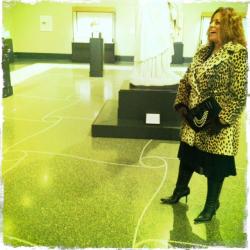Direct experience has taught me that I am an urban soul. A few years ago, a spontaneous self-exile in a rural, sodden, frigid, isolated northerly burg confronted me with hideously engorged ticks clinging to the faces of my beloved cats (Lyme disease-laden ticks carried by the cute local deer, I might add), and bats wheeling around the drafty heights of the master bedroom. Ye gods! I beat it back to the safety of the asphalt jungle as fast as my kitten-heels could carry me.
Suffice to say that, while I appreciate nature, I now freely admit that I also appreciate my status as the apex predator. For any saps who need reminding of this privilege, please rent Werner Herzog’s “Grizzly Man.”
Unlike my native Brooklyn, Los Angeles– even at her grittiest–offers an unexpected array of moments where nature and asphalt meet. It’s May, so it’s seasonally correct to mention Asahi Fancy Koi, a radiant meditation located in one of Gardena’s more frankly bleak industrial stretches.
The month of May is traditionally when the Nakamaru family, who founded and own this business, import “small” Nishiki-goi Koi from Japan. In November, they import the big guys.
I am not a Koi expert of any kind. I do find it remarkable that these mythic fish, some of which measure close to two feet in length in their prime, could be related to the common carp–possibly those I glimpsed in bathtubs in Brooklyn, usually in anticipation of a major holiday feast?
I almost literally stumbled upon Asahi Fancy Koi when I worked in an office building a few blocks away. I walked each day at lunch for 30 minutes– any excuse to jump the fence.
The area calls itself Harbor Gateway, which epitomizes poetic license, and which I appreciate. It’s not far from the Dominguez Hills campus, and the Home Depot stadium. One day as I walked down 190th Street, I found myself within a few feet of parking-lot gunfire. Digruntled employee? We can all relate. No big whup.
On the upside, the Goodyear blimp often purrs slowly overhead (it’s moored nearby), and some mornings, the entire grid smells of Hawaiian bread, wafting from the company’s huge bakery.
Surprise: tucked between the cement-factory, Herbalife compounds and grime-windowed, no-name body shops, a moment of surreal awakening amidst gleaming, regal creatures beloved in Japan not only for their beauty, but also for their vigorous fighting spirit.
Those Koi which I imagine to be overachievers swim in one of two masterfully landscaped mega-ponds, framed by moist sprays of blooming orchids and smooth stones.
The depth of these ponds is graded, deep-to-shallow, back to front; this brings the Koi closer to the surface in the areas nearest the walkway, for easier viewing and inspection. Their scales glint bronze, obsidian, copper, slate, blood-orange, platinum. They will occasionally break the surface, seeming to reach out with their sensitive barbels as you pass and pause, then rocket off to the jade-glossy depths, far at the other end.
The rest swim in enormous, pristine cement ponds of crystal-clear water. They are grouped by size and price. The price tag for some reaches into the several-thousands of dollars. Missing: even a whiff of chlorine tank-shtank, algae, slime, muck, murk, funk, fish poop, or the general aquatic cloudiness which accompanied my many years of feeder goldies from the dime-store.
In addition to supplying the fish themselves, the AFK team also offers design services, for the planning and construction of a Koi pond, as well as expert ongoing Koi pond care and maintenance. See above reference to algae, et al. AKF will also consult with Koi-fanciers in the event of sick Koi (i.e., identify parasites or other causes for unhappy waters), even if the fish in question was purchased from a competitor.
Asahi Fancy Koi sparkles, silently. In a different tradition, I’ve had it explained to me by more than one person of Chinese heritage that Asian restaurants often have goldfish tanks by the front door, not so much for the obvious gold-reference, but for the deep and unseen Feng Shui benefits of moving water.
Perhaps this was what drew me there almost daily to watch the Koi glide in hypnotic no-patterns that seemed as formal and perfect as any mathematical equation.
–Victoria Thomas



